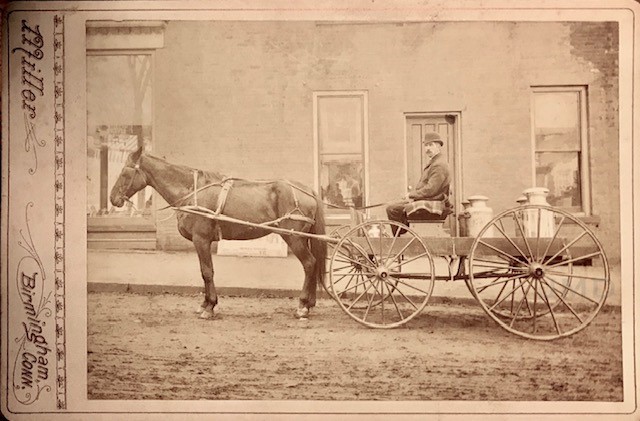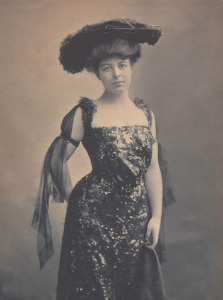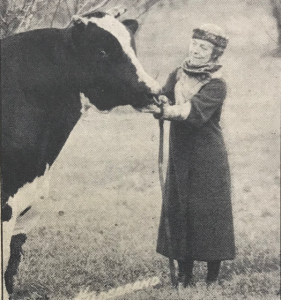By Joseph M. DiRienzo
Like many rural areas across the United States, the Lower Naugatuck Valley has had its share of dairy farms. In 1975, Connecticut had a little over eight hundred milk-producing farms. By 2018, however, only 150 licensed dairy farms remained in the state. A family legacy developed and expanded by Frances Kellogg, Derby’s Osbornedale Farms stands out due to its lasting impact on the Holstein-Friesian breed and contributions to the dairy industry.
The Osborne Family’s Dairy Beginnings
The Osborne family got its start in dairy agriculture when Wilbur Fisk and Ellen Lucy Osborne and their family bought an 1840 farm in Derby and began experimenting with the cross breeding of Jersey cows and Red Polled cattle. In addition to agriculture, Wilbur also carried on his family’s manufacturing legacy as an incorporator of both the Derby Silver Company and the Schneller, Osborne, and Cheesman (S.O.&C.) Company of Ansonia.
Despite failing to graduate from public school after accidentally losing sight in one eye, Frances Osborne (Wilbur and Ellen’s only child to survive to adulthood) successfully took over the family business following Wilbur’s death in 1907. In 1919, Frances married the New York architect Waldo Stewart Kellogg, who moved to join her at the Osborne estate in Derby. While Kellogg continued as an architect during the beginning of their marriage, he soon became interested in the farm and the Holstein-Friesian breed.
Development of Osbornedale Farms
The Kelloggs expanded the farm by purchasing adjacent properties, consolidating about four hundred acres to form two farming operations under the name Osbornedale Farms. The original farm specialized in the breeding of Holstein-Friesian cows and production of Grade A Holstein milk. The other farm—previously owned by the Bassett family—concentrated on high quality milk production using Jersey cows.
The Kelloggs bought their foundation stock in 1920 at the peak of the Holstein boom and in 1927 purchased “Sir Bess Ormsby May” and “Sir Piebe Inka May Fayne.” These two sires had champion pedigrees and became the cornerstones of the Osbornedale herd.
Frances continued to breed and raise cattle after Waldo’s death in 1928. In the 1930s, she hired Fred M. Nichols as farm manager and was elected president of the Connecticut and New England Holstein-Friesian Associations. At the time, the farm had 160 registered Holsteins and the herd increased to 180 head by 1940.
After spending most of her life building upon her family’s legacy, Frances Kellogg died in November 1956. In May 1957, the Osbornedale herd was dispersed at a public auction held at Osbornedale Farms. The 144 cows sold for an average price of $1,182—one of the bulls, named “Wis Maestro,” sold for $30,000.
Animal Breeding and the Legacy of Frances Kellogg

Osbornedale State Park sign – Wikimedia Commons. Used through a CC BY-SA 4.0 license.
Frances Kellogg’s selective genetic breeding prowess can be traced to one of her own Holstein-Friesian bulls used to improve the herd. “Osborndale Ivanhoe”—the offspring of the bull “Osborn Ty Vic” and cow “Abbek Gay”—was born in Derby on April 26, 1952 and was the pinnacle of the breeding program. He stood about six feet tall with a wide stance, a good length and had what farmers call “dairy strength.”
Ivanhoe was sold to the American Breeders Service as a young adult and was one of the first bulls to gain international influence through artificial insemination (today, approximately 60% of American dairy calves are conceived by artificial insemination). Ivanhoe sired more than one hundred sons and five thousand daughters leading to an estimated one hundred thousand direct descendants—including those born up to 20 years after his death in 1963. He became one of the five most influential bulls for the Holstein-Friesian breed. One of his grandsons, “Round Oak Rag Apple Elevation,” has produced an estimated 8.8 million children and grandchildren and is considered the single most influential Holstein-Friesian bull of the last century.
Frances Kellogg lived her entire life on the family dairy farm where she became one of America’s foremost ladies in the field of animal breeding. In addition to her unparalleled contributions to the dairy industry, Frances was very involved in community activities and organizations. She was on the boards of numerous institutions including the Connecticut Forest and Parks Association, the Griffin Hospital, the Birmingham National Bank, and Derby Neck Library (which her father, Wilbur Osborne, founded). Finally, upon her death, she deeded her homestead, farms, and additional real estate holdings to the State of Connecticut. These properties, totaling around four hundred acres, became the Osborne Homestead Museum, Kellogg Environmental Center, and Osbornedale State Park.
Joseph M. DiRienzo, PH.D. Emeritus Professor of Microbiology, University of Pennsylvania and Member of the Board of Directors of the Derby Historical Society. He writes a weekly local history post for the society’s Facebook page.











